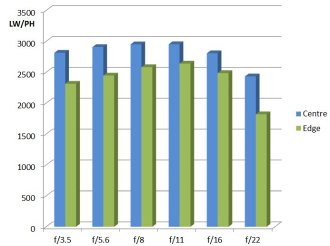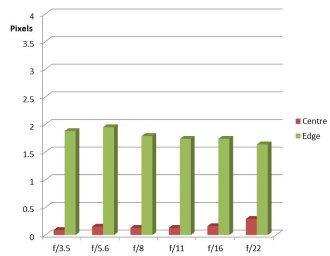HD Pentax-D FA 28-105mm f/3.5-5.6 ED DC WR Lens Review
HD Pentax-D FA 28-105mm f/3.5-5.6 ED DC WR Performance
Looking at how the lens performs is very interesting, and very encouraging for potential K-1 purchasers. The idea that a “kit lens” is in some way inferior is absolutely not so in this instance. The reduction in cost reflects the use of plastics and the variable aperture design. This makes for a lower cost, lighter and more compact design but the performance reflects the same rationale as all the other new lenses tested alongside.
As an overall generalisation, the ethos of the design seems to be a high standard of sharpness, very evenly spread across all the apertures and focal lengths. Zoom lenses tend to be much sharper in the centre of the field than the edges, and a higher standard at the wider focal lengths. This 28-105mm is a much more balanced performer.
How to read our charts
The blue column represents readings from the centre of the picture frame at the various apertures and the green is from the edges.The scale on the left side is an indication of actual image resolution as LW/PH and is described in detail above. The taller the column, the better the lens performance.
For this review, the lens was tested on a Pentax K-1 using Imatest.
At 28mm we see -3.26% barrel distortion, fairly typical for a lens of this type. CA (Chromatic aberration) is very well controlled at the centre, and less so at the edges. This can, of course, be dealt with in software.
How to read our charts
Chromatic aberration is the lens' inability to focus on the sensor or film all colours of visible light at the same point. Severe chromatic aberration gives a noticeable fringing or a halo effect around sharp edges within the picture. It can be cured in software.
Apochromatic lenses have special lens elements (aspheric, extra-low dispersion etc) to minimise the problem, hence they usually cost more.
For this review, the lens was tested on a Pentax K-1 using Imatest.
Sharpness at 28mm is very good, centre and edge, falling to good at f/22 centrally and at f/3.5 and f/16 at the edges. The edges at f/22 are softer and this aperture is best avoided unless depth of field is the major requirement.
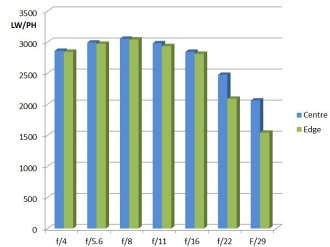 |
 |
| MTF @ 35mm | CA @ 35mm |
At 35mm distortion is -0.941% barrel, which is very satisfactory for a standard zoom lens. The CA figures are commendably low and not a problem in images. In any event, CA can be tacked in software.
Central sharpness at 35mm is very good from open aperture through to f/22, just weakening at f/29 but still being good. Edge sharpness is very good from wide open to f/16, good at f/22 and just fair at f/29. What is remarkable is that centre and edge give almost identical measurements from f/4 to f/16. The high sharpness is evident all across the image area and clearly Pentax have been determined that their lenses will give a good account of the full frame format.
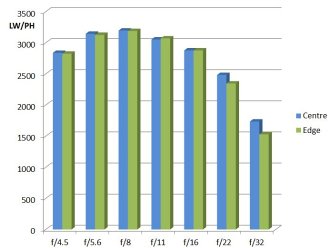 |
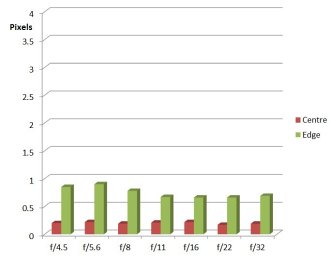 |
| MTF @ 50mm | CA @ 50mm |
At 50mm we find +1.09% pincushion distortion, which is very acceptable. Image sharpness is very good and incredibly even across the frame from f/4.5 to f/16. Only f/32 drops to only a fair standard, which is not unexpected in most lenses. CA is very tightly controlled and any residual fringing can be attended to in software or by the camera.
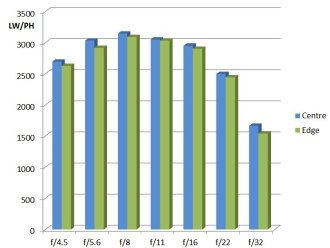 |
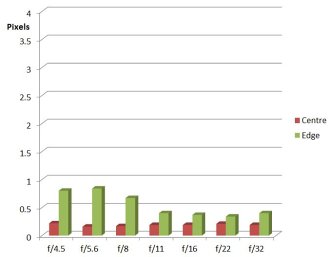 |
| MTF @ 70mm | CA @ 70mm |
At 70mm pincushion distortion rises to +1.55%, still a reasonable value. CA becomes even better controlled and is not a problem. The figures recorded are excellent, and all the more so for being from a standard zoom lens. Image sharpness shows the same remarkable evenness from f/4.5 to f/22, with f/32 dropping away to only fair. It is also worth noting that, unlike many zooms, sharpness has been maintained at the same level right from 28mm up to the telephoto lengths, without any weakening.
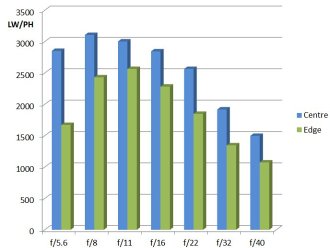 |
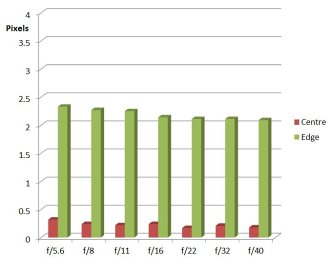 |
| MTF @ 105mm | CA @ 105mm |
105mm gives +1.6% pincushion distortion, again very good. This is the point at which CA at the edges worsens slightly, although the actual effect in the images is not that apparent with most subjects. Sharpness is maintained at very good levels at the centre from wide open to f/22, dropping to fair at f/32 and f/40. At the edges we seem to have reached some limitation in the design, sharpness starting off fair at f/5.6, being very good at f/8 and f/11, good at f/16 and dropping to fair beyond that.
In summary, the lens design is very appealing, offering the opportunity to really take advantage of the larger format. Centre and edge sharpness is very high throughout, but more than that it is very evenly matched across the frame, regardless of focal length. It is only at full stretch that it falls way at the edges. However, to be fair that means apertures of f/22 to f/40, where diffraction is bound to have any real effect.
Bokeh, the quality of the out of focus areas in an image, is very attractive. It is smooth and subtle. Flare is not a problem, being very difficult to induce at all. The new HD coating is clearly doing its job and with so many elements in current lenses it needs to be able to.
Value For Money
As the least expensive option to start off with the new K-1 body, this has to be seen as great value compared to the more expensive alternatives. The opening price of the HD Pentax-D FA 28-105mm f/3/5-5.6 ED DC WR is £549 if purchased separately, but of course the way forwards is to buy with the K-1 as a package. Then the figures change dramatically and the lens might cost as little as £419.
Looking at what users of other marques have available, there are no real exact equivalents. However, Sigma do offer for Canon and Nikon the Sigma 24-105mm f/4 DG OS HSM (£599). Canon have the EF 24-105mm f/3.5-5.6 IS STM (£375) and Nikon the Nikon 24-120mm f/4 G AF-S ED VR (£849).
Add your message
Please login here or if you've not registered, you can register here. Registering is safe, quick and free.
photodo Stats
428 MTF tests
74 in-depth photodo reviews
100+ users join each day
Help the lens community by reviewing or rating a lens today via our lens search
Latest Lens Reviews
- Chinon 28mm f/2.8 Vintage Lens Review
- Canon EF 70-200mm f/4L IS II USM Lens Review
- Samyang AF 85mm f/1.4 EF Review
- Sigma 70mm f/2.8 DG Macro Art Review
- Samyang AF 24mm f/2.8 FE Review
- Meike 50mm f/1.7 Review
- Tamron 70-210mm f/4 Di VC USD Review
- Lensbaby Burnside 35mm f/2.8 Review
- Asahi Super Takumar 50mm f/1.4 Review
- Asahi Super-Multi-Coated Takumar 135mm f/3.5 Review
